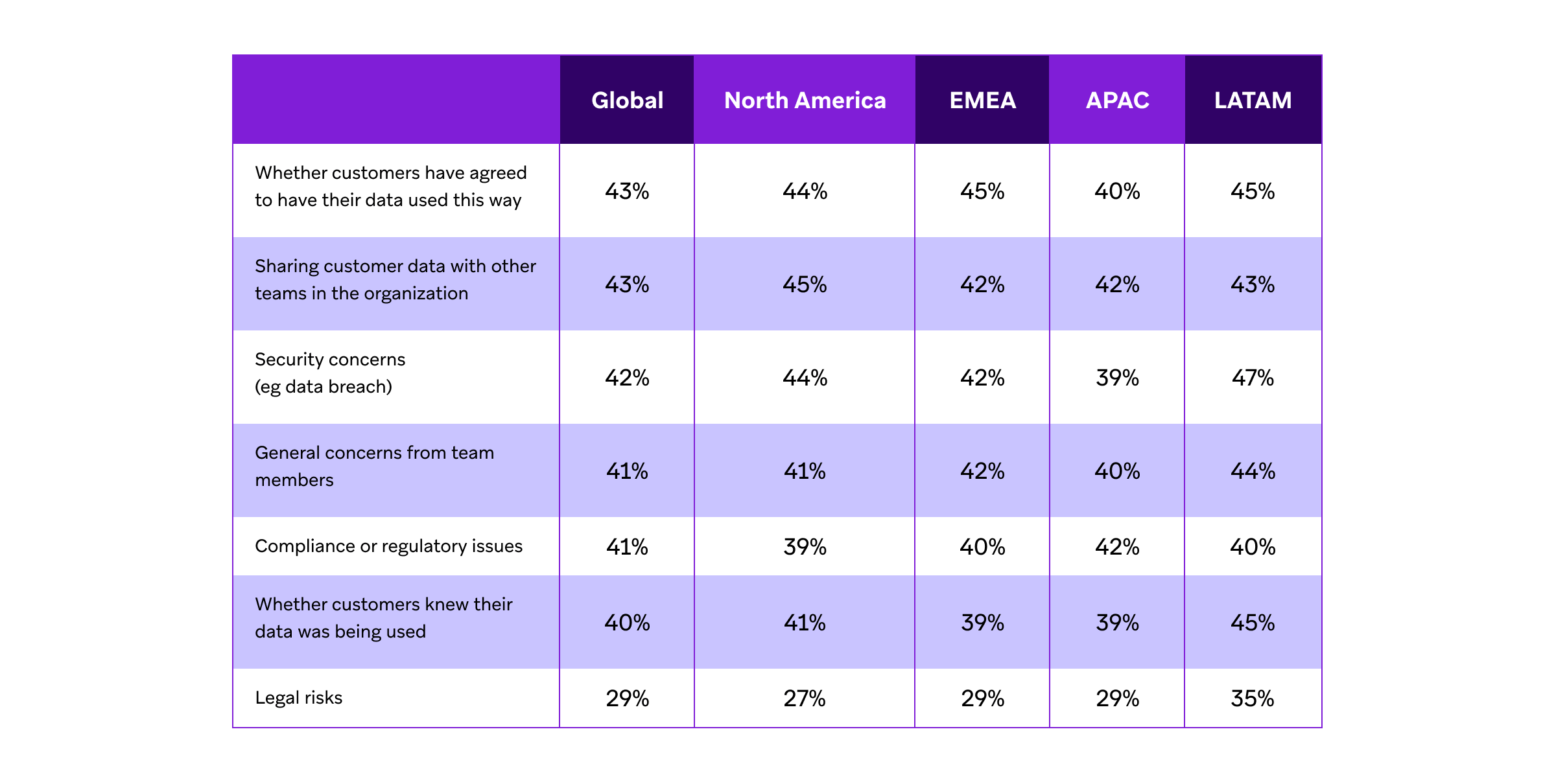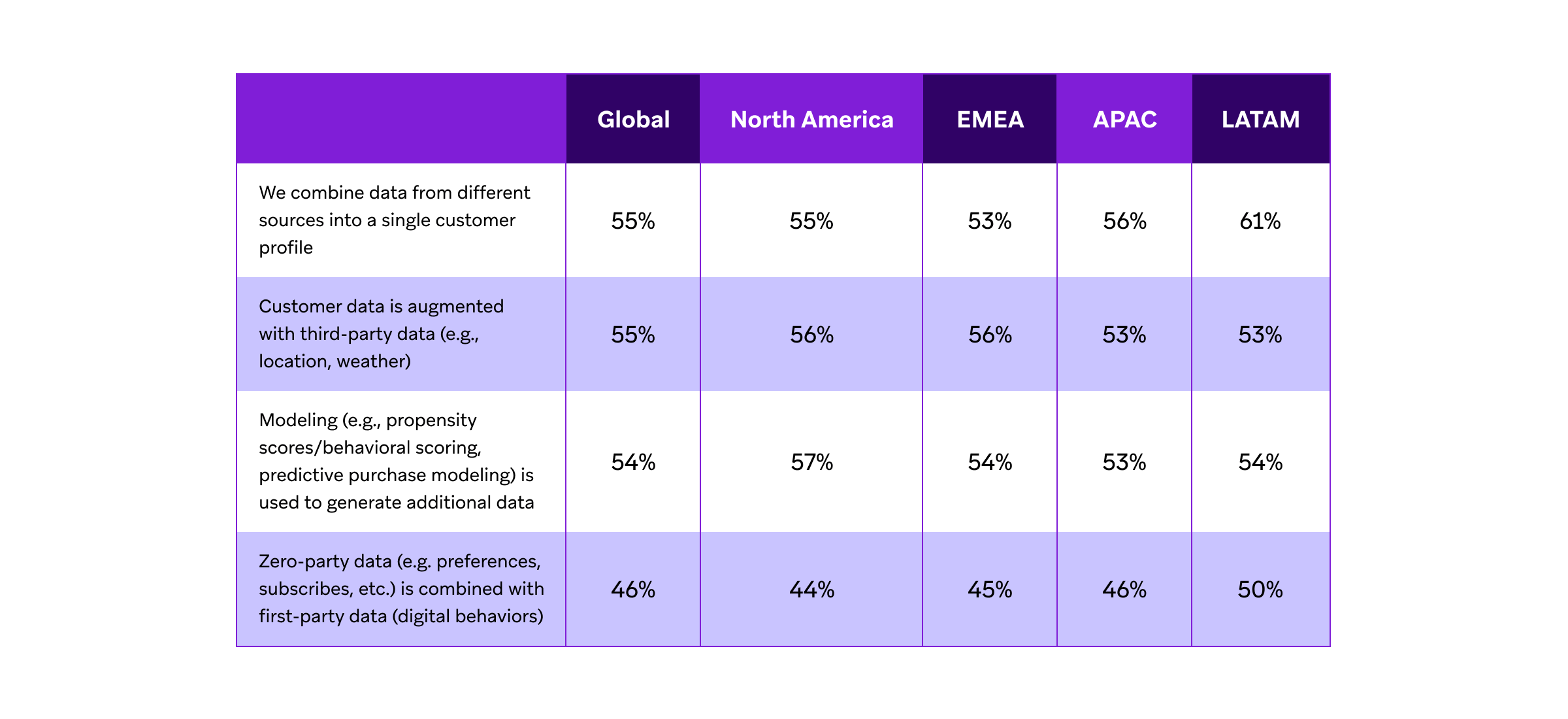Overcoming data privacy problems: How high concern drives advanced personalization
Published on June 13, 2025/Last edited on July 09, 2025/6 min read


Team Braze
Advanced personalization relies on openness and trust to succeed. But privacy concerns are holding brands back. According to our 2025 Global Customer Engagement Review, nearly all surveyed marketers (99%) say privacy concerns impact their personalization efforts.
While brands do need the right tools to stream data and personalize messages, it’s clearly not just about tech—it’s about trust. Customers need to trust you before they share their data. And your teams need to trust your systems and safeguards enough to personalize with confidence.
We’ve dug into regional data to understand how different parts of the world feel about data and privacy. And we’ll contrast that with their data practices to see how they bring these concerns to bear.
How the world feels about data and privacy
We surveyed 2,300 marketing leaders across 18 countries and asked, ‘What data privacy concerns within your organization have ever impacted your organization’s plans for more advanced personalization?’ We wanted to understand what’s holding marketers back, beyond the usual tech, time, or team capabilities.
We gave options around:
- Consent – Whether customers knew about and agreed to data use, plus regulatory compliance
- Internal confidence – Whether team members feel comfortable using and sharing customer data
- Risk aversion – Concerns around security and legal risks
When it comes to using data for personalization, every region has its own mix of caution and confidence, from the more relaxed approach of Asia-Pacific to the heightened vigilance of Latin America. Here’s what we discovered.

APAC: The most relaxed respondents
Brands surveyed across the Asia-Pacific region seem to be the most at ease. They’re less worried than their global peers about whether customers have consented to or are aware of how their data is being used, and they report relatively low concern around internal data sharing and security.
The one area where their concern rises slightly is compliance. Countries like India, China, and Australia have introduced or updated privacy laws in recent years, and that shifting legal landscape may be contributing to concerns.

EMEA: Confident but with questions
The surveyed EMEA brands are fairly comfortable when it comes to legal, compliance, and security issues, tracking just below or at the global average for concern. They’re also less worried about sharing data between teams. This could be due to European countries operating under more mature and embedded privacy laws, like the GDPR, resulting in more confident data practices.
However, while they’re more confident that customers know their data is being used, they’re less sure whether customers actively agreed to it. That poses an interesting question about how that gap forms and how brands could strengthen this area of consent.

North America: Trust and caution
North American brands that were surveyed feel relatively confident about customer consent and regulatory issues, with slightly lower-than-average concern around legal and compliance risk. But they do express more worry around internal dynamics, particularly sharing customer data across teams.
They also show the highest level of concern about security breaches. That likely reflects the legal and reputational pressure of operating in this mature and often litigious market. It’s not about not knowing what to do, it’s about staying safe while doing it.

LATAM: The most cautious overall
Brands surveyed in Latin America report the highest level of concern across nearly every category. They are particularly troubled by whether customers have agreed to and are aware of how their data is being used, and show significant concern around security and legal risks. This could suggest a challenging environment in terms of consent, compliance, and cybersecurity.

Personalization in practice: how the regions use data
Interestingly, you might expect that LATAM’s higher level of caution around privacy would translate into slower adoption of advanced data strategies. But the data tells a different story. Far from being held back, LATAM brands appear to be among the most sophisticated in how they combine and use data to power personalized marketing.
We asked marketers how they bring together different sources of data to plan for future campaigns, and LATAM came out on top in several key areas.

Based on the survey results, LATAM brands are the most likely to build a single customer profile by integrating data from across touchpoints, which is a clear sign of operational maturity. They’re also more likely than any other region to combine zero-party data (volunteered information such as customer preferences and opt-ins) with first-party digital behavior. That’s a strong marker of trust, suggesting customers are actively choosing to share their information with brands.

Meanwhile, our survey revealed that North American brands also exhibit a strong data strategy, albeit with a different emphasis. They’re more likely to use predictive modeling than zero-party data. This speaks to a mature data culture, one with the team and advanced tools needed for analysis, compared to other regions.
This is supported by North America’s high score for tooling to manage multiple channels in our survey, with 30% at Ace level compared to a global average of 27%, with LATAM trailing at 24%. However, it may also speak to a different trust dynamic, with North America leaning into what they can infer from existing data, rather than soliciting new data from customers.

Elsewhere, both EMEA and APAC largely follow global trends in how they use data. But there are a couple of areas where there’s room to grow. Surveyed EMEA brands are slightly less likely to bring data together into a single customer profile or to use zero- and third-party data to add more relevance to their messaging. In APAC, surveyed brands are very slightly behind the curve with predictive modeling and using third-party data to add context to messaging.
High concern drives advanced personalization
Every region approaches data privacy and personalization a little differently, shaped by local regulations and perceptions of risk.
In LATAM, high concern seems to drive highly considered strategies, ones that win customer trust and enable sophisticated personalization based on volunteered data. While in North America, advanced modeling and inferred intent help plug data gaps arising from collection or internal sharing issues.
What’s clear is that teams need to build trust on two fronts:
- With customers, to secure their consent for communication and valuable volunteered first-party data
- Within their organization, to make sure marketers are confident that they’re sharing and using customer data in a way that is compliant, relevant, and enhances the customer experience
For actionable tips on how to do this, download the Braze Global Customer Engagement Review 2025 and discover how high-performing brands:
- Prioritize customer consent to deliver real value from data collection
- Leverage messaging to support transparency around data usage
- Manage data to confidently deliver personalized experiences
Related Tags
Be Absolutely Engaging.™
Sign up for regular updates from Braze.
Related Content
View the Blog
How behavioral marketing turns data into personalized experiences

Team Braze

How Braze supports exceptional customer engagement during Black Friday, Cyber Monday, and beyond

Todd Grennan

How to overcome messaging fatigue this holiday season
